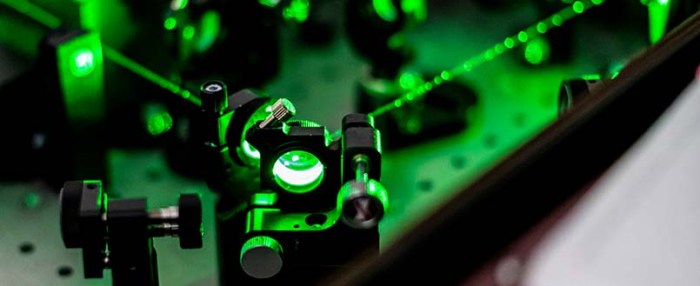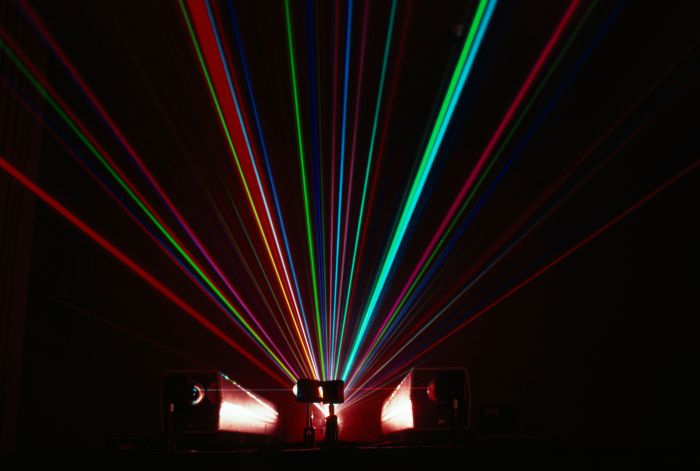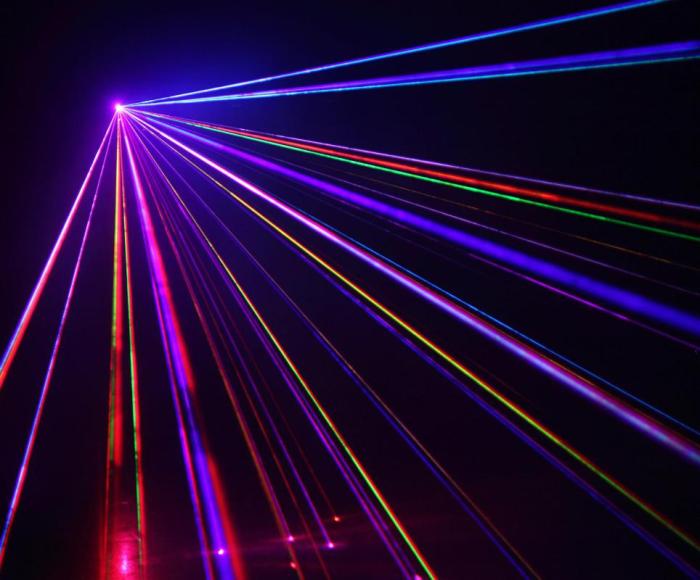Noble gas used in lasers – Noble gases, known for their inert nature, play a crucial role in the realm of lasers, enabling the generation of coherent and intense beams of light that have revolutionized various fields.
These unique elements, with their exceptional properties, serve as the heart of lasers, offering advantages and applications that are both diverse and fascinating.
Noble Gas Properties

Noble gases, also known as inert gases, are unique elements that possess exceptional properties making them ideal for use in lasers. Their distinctive characteristics contribute to the efficient generation and amplification of laser light.
Noble gases are characterized by their low reactivity and high ionization energy. This inertness stems from their complete electron shells, resulting in a stable and unreactive nature. These properties make them suitable for use in lasers, as they do not readily react with other substances, ensuring the longevity and stability of the laser system.
Examples of Noble Gases Used in Lasers
- Helium (He): Helium is a lightweight gas with a high ionization energy. It is commonly used in helium-neon (HeNe) lasers, which produce continuous-wave (CW) laser light in the visible spectrum.
- Neon (Ne): Neon is another noble gas used in lasers. It is employed in HeNe lasers, along with helium, to generate laser light in the red and orange wavelengths.
- Argon (Ar): Argon is a heavier noble gas with a lower ionization energy compared to helium and neon. It is used in argon-ion (Ar+) lasers, which produce CW laser light in the visible and ultraviolet (UV) spectrums.
- Krypton (Kr): Krypton is a noble gas with a relatively high ionization energy. It is utilized in krypton-ion (Kr+) lasers, which generate laser light in the visible and near-infrared (NIR) regions.
- Xenon (Xe): Xenon is a heavy noble gas with a low ionization energy. It is employed in xenon-ion (Xe+) lasers, which produce laser light in the visible, NIR, and UV spectrums.
Advantages of Using Noble Gases in Lasers
- High Efficiency: Noble gases have high ionization energies, making them efficient in generating laser light. They readily emit photons when excited, leading to efficient light amplification.
- Long Lifespan: Noble gases are chemically inert, which contributes to the longevity of lasers. They do not react with other substances, ensuring the stability and extended lifespan of the laser system.
- Variety of Wavelengths: Different noble gases emit laser light at specific wavelengths, providing a range of options for various applications. This versatility allows lasers to be used in diverse fields, from medical to industrial.
Disadvantages of Using Noble Gases in Lasers
- Cost: Noble gases can be expensive, especially for high-power lasers. This cost factor can limit the accessibility and affordability of noble gas lasers.
- Limited Power Output: Compared to other laser media, noble gas lasers typically have lower power outputs. This limitation can hinder their use in applications requiring high-power laser sources.
- Safety Considerations: Some noble gases, such as helium and neon, are non-toxic. However, others, like argon, krypton, and xenon, can be hazardous if inhaled. Proper ventilation and safety measures are crucial when working with these gases.
Laser Types and Noble Gases: Noble Gas Used In Lasers
Noble gases play a crucial role in various laser types, enabling them to emit highly coherent and intense beams of light. These lasers find applications in diverse fields, including medicine, manufacturing, and scientific research.
Helium-Neon Laser
Helium-neon lasers utilize a mixture of helium and neon gases. Helium atoms are excited by an electrical discharge, which then transfer their energy to neon atoms. The neon atoms emit photons at specific wavelengths, typically in the visible spectrum (633 nm and 1152 nm).
Helium-neon lasers are widely used in:
- Barcode scanners
- Laser pointers
- Medical imaging and laser surgery
Argon-Ion Laser
Argon-ion lasers use ionized argon gas. The electrical discharge excites argon ions, which emit photons in the visible and ultraviolet spectrum (458 nm to 530 nm). These lasers are known for their high power and continuous output.
Applications of argon-ion lasers include:
- Medical laser treatments (e.g., laser eye surgery)
- Industrial material processing (e.g., laser welding)
- Scientific research (e.g., laser spectroscopy)
Krypton-Ion Laser
Krypton-ion lasers are similar to argon-ion lasers, but they utilize ionized krypton gas. These lasers emit photons in the visible and ultraviolet spectrum (468 nm to 752 nm) and are characterized by their long wavelength output.
Krypton-ion lasers are used in applications such as:
- Laser light shows
- Medical laser therapy
- Scientific research (e.g., laser-induced fluorescence)
Excimer Laser, Noble gas used in lasers
Excimer lasers utilize noble gases in combination with other gases (e.g., fluorine, chlorine) to produce short-wavelength ultraviolet radiation. These lasers are characterized by their high power and short pulse duration.
Excimer lasers are used in applications such as:
- Laser eye surgery (e.g., LASIK)
- Microelectronics fabrication
- Medical imaging (e.g., photolithography)
Noble Gas Excitation and Emission

Understanding the excitation and emission processes of noble gases is crucial for comprehending the operation of noble gas lasers. These processes involve the absorption of energy by noble gas atoms, followed by the release of this energy in the form of light.
In a noble gas laser, the excitation of atoms occurs through various methods, including electrical discharge, optical pumping, and electron beam excitation. During electrical discharge, a high voltage is applied across the laser tube, causing the ionization of noble gas atoms.
Noble gases like helium and neon are used in lasers, which are widely used in dentistry for procedures such as dental etch burn on lip. Dental etch burn on lip is a common issue that can occur during dental procedures.
Fortunately, lasers used in dentistry are designed to minimize such risks and provide precise and effective treatment. The use of noble gases in these lasers ensures their safe and efficient operation.
These ionized atoms then collide with other atoms, transferring their energy and exciting them to higher energy levels.
Optical Pumping
Optical pumping is another method of excitation used in noble gas lasers. In this technique, a high-intensity light source, typically a flash lamp, is used to excite the noble gas atoms. The photons from the light source are absorbed by the atoms, promoting them to excited states.
Electron Beam Excitation
Electron beam excitation involves directing a beam of high-energy electrons into the laser tube. These electrons collide with noble gas atoms, transferring their energy and exciting them. This method is particularly useful for producing high-power lasers.
Once the noble gas atoms are excited, they undergo spontaneous emission, releasing photons of light as they return to their ground state. The wavelength of the emitted light depends on the energy difference between the excited and ground states of the atom.
The intensity of the laser output is influenced by factors such as the number of excited atoms, the efficiency of the excitation process, and the optical cavity design.
Laser Design and Construction

The design and construction of lasers using noble gases involve careful considerations to optimize performance and meet specific application requirements.
The materials and components used in noble gas lasers play a crucial role in determining the laser’s characteristics, such as wavelength, power, and stability. Common materials include:
- Gas Discharge Tubes:Made of materials like quartz or glass, these tubes contain the noble gas and provide a medium for electrical discharge.
- Electrodes:Used to generate an electric field within the discharge tube, stimulating the noble gas atoms.
- Mirrors:Highly reflective surfaces placed at the ends of the discharge tube, forming the optical resonator.
- Cooling Systems:Essential for managing heat generated during laser operation, maintaining stable operating conditions.
Laser Designs
Different laser designs exist, each with its unique advantages and applications:
- Helium-Neon (HeNe) Lasers:Compact and reliable, emitting visible red light (632.8 nm) and used in various applications, including barcode scanners and laser pointers.
- Argon-Ion (Ar+) Lasers:Produce multiple visible and ultraviolet wavelengths, used in scientific research, medical treatments, and material processing.
- Krypton-Ion (Kr+) Lasers:Similar to Ar+ lasers, emitting a range of visible and ultraviolet wavelengths, with applications in laser shows and medical procedures.
- Xenon Chloride (XeCl) Lasers:Produce ultraviolet light (308 nm), used in semiconductor lithography and laser-induced fluorescence spectroscopy.
Safety and Applications

Noble gas lasers require careful handling and safety precautions due to their high power and potential hazards. Proper training and adherence to safety protocols are essential to minimize risks.
When working with noble gas lasers, it is crucial to:
- Wear appropriate protective gear, including laser safety glasses, gloves, and a lab coat.
- Ensure the laser area is well-ventilated to prevent gas accumulation.
- Avoid direct exposure to the laser beam and its reflections.
- Handle high-voltage components with caution and follow proper electrical safety procedures.
Applications
Noble gas lasers have diverse applications across research, industry, and medicine. Their unique properties, such as high power, precise wavelength, and beam quality, make them ideal for various tasks.
- Research:Noble gas lasers are employed in scientific research, including spectroscopy, microscopy, and laser-induced fluorescence.
- Industry:These lasers are used in material processing, laser cutting, welding, and engraving.
- Medicine:Noble gas lasers find applications in laser surgery, dermatology, and ophthalmology.
Specific examples include:
- Helium-neon lasers are used in laser pointers, barcode scanners, and optical alignment systems.
- Argon-ion lasers are employed in laser surgery, ophthalmology, and dermatology.
- Krypton-ion lasers are used in scientific research and laser lighting.
- Excimer lasers (e.g., argon fluoride and krypton fluoride lasers) are utilized in semiconductor manufacturing and laser eye surgery.
Questions Often Asked
What are the advantages of using noble gases in lasers?
Noble gases offer high efficiency, long operational lifetimes, and the ability to produce specific wavelengths, making them ideal for various laser applications.
Which noble gases are commonly used in lasers?
Helium-neon (HeNe), argon-ion (Ar+), and carbon dioxide (CO2) are among the most widely used noble gases in lasers.
How do noble gases generate light in lasers?
When noble gas atoms are excited, they emit photons of specific wavelengths, resulting in the production of coherent and intense laser light.